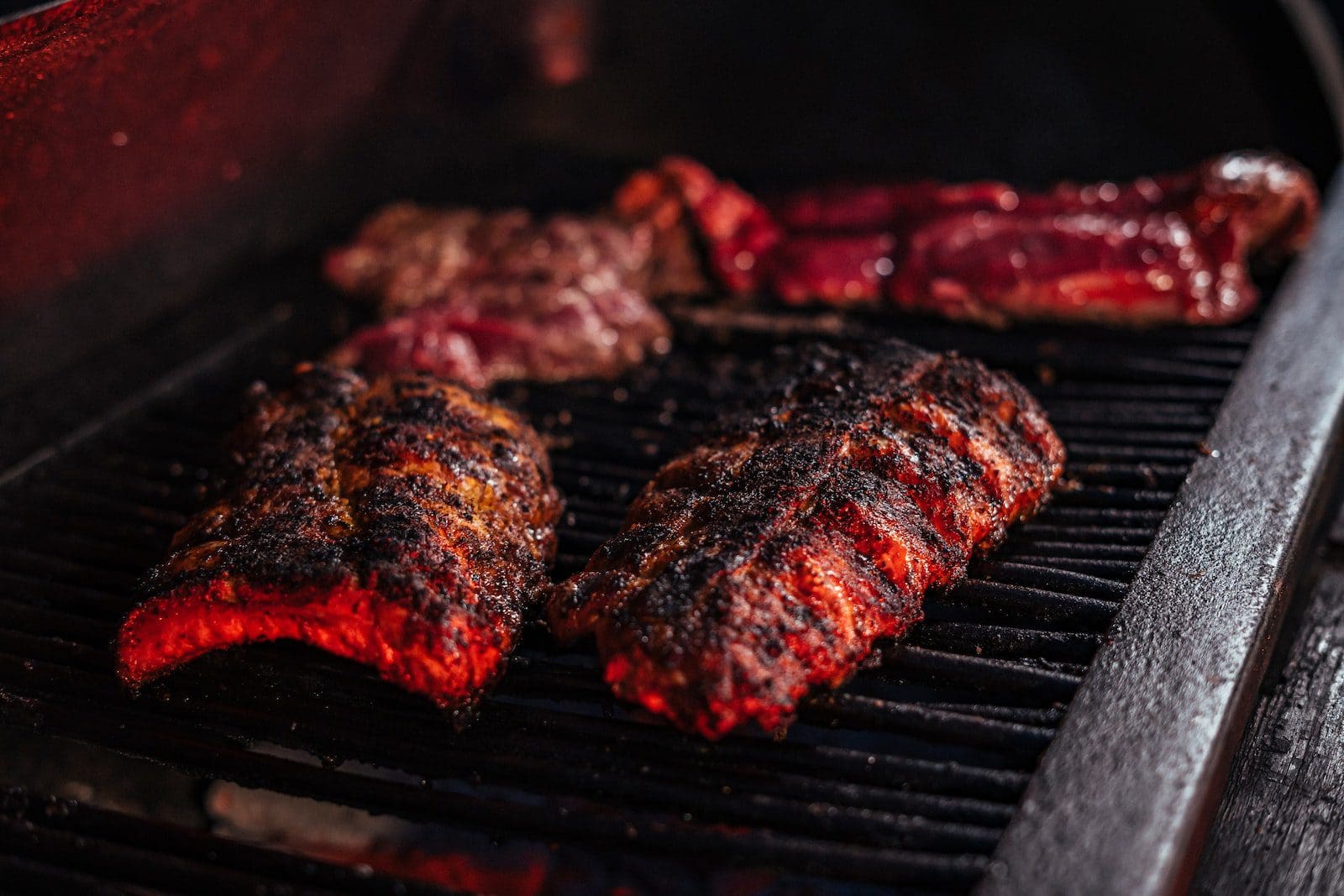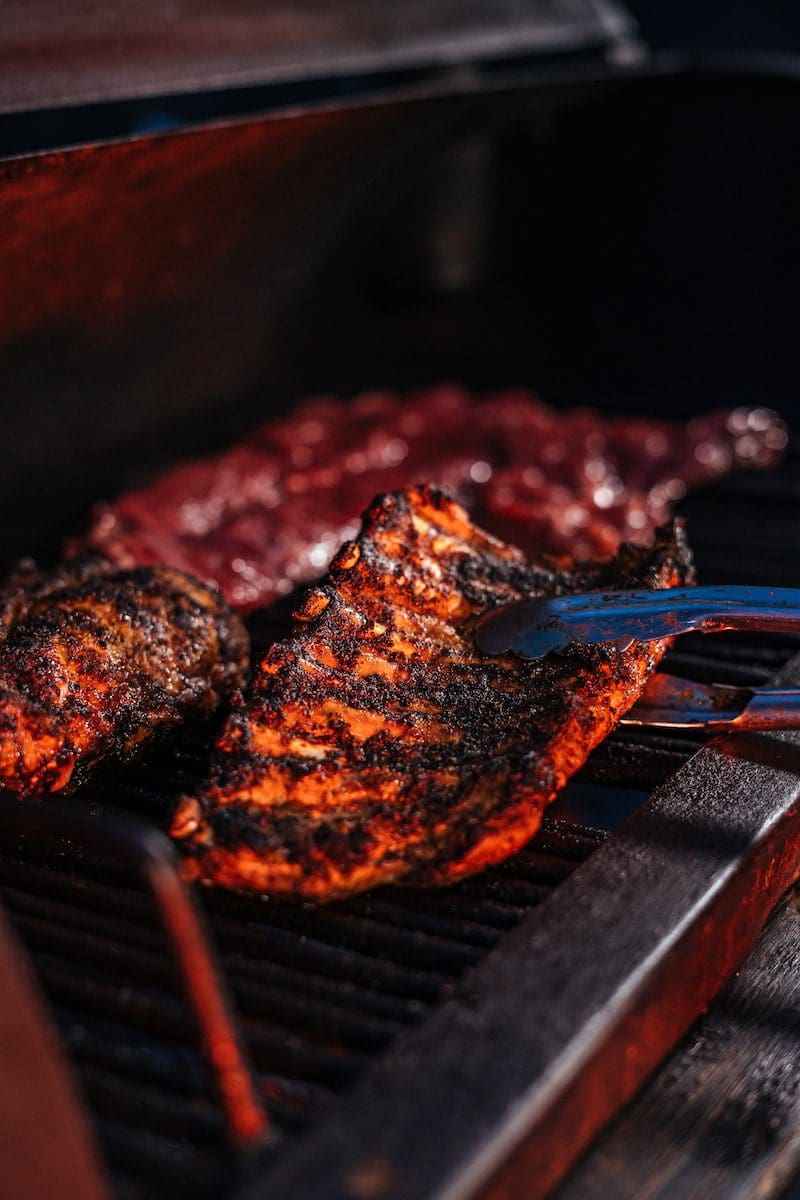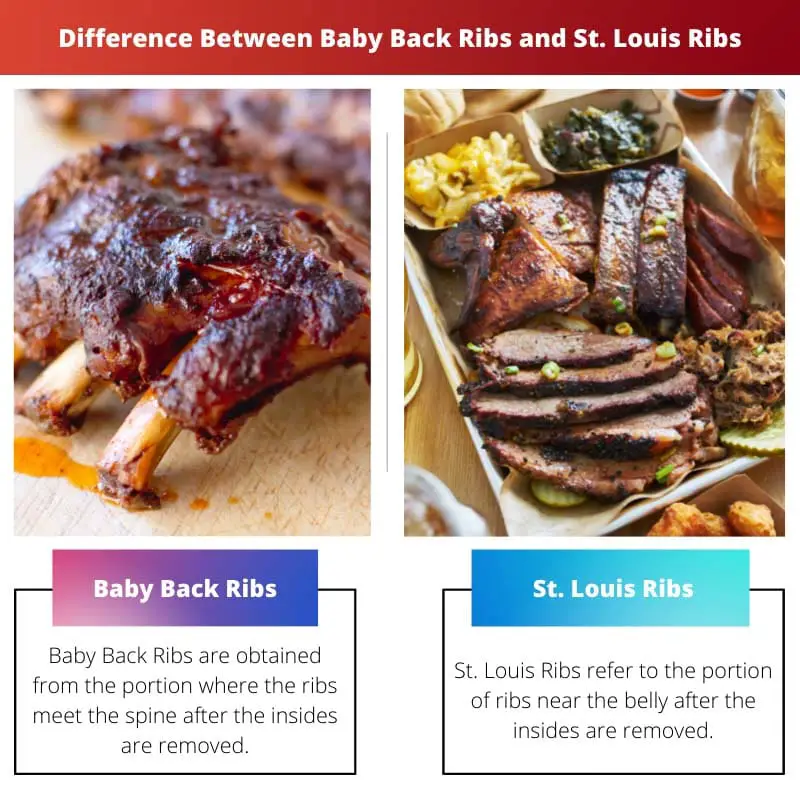When it comes to barbeque meant, pork ribs are the best shot. Pork meat is known for its beef-like texture yet tenderness due to the high percentage of fat in the body.
Different portions of the animal are sold commercially with different names. Each of these pieces has its speciality and recipes that are best suited to it.
Key Takeaways
- Baby back ribs come from the upper rib cage, while St. Louis ribs originate from the lower rib cage.
- St. Louis ribs are larger and flatter, ideal for smoking and grilling, whereas baby back ribs are smaller and curved, great for oven baking.
- Baby back ribs tend to be more tender and leaner, while St. Louis ribs have a more fat and robust flavor.
Baby Back Ribs vs St. Louis Ribs
Baby Back Ribs are curved and short; St Louis Ribs are flatter and straighter. Baby Back Ribs are more popular compared to St. Louis Ribs. St. Louis Ribs have a meatier texture that is fattier, while Baby Back Ribs have leaner meat. St. Louis ribs have a more notable flavour compared to Baby Back Ribs.

Baby Back Ribs refer to the upper ribs of a pig that is consumed and cooked after removing cartilage and bones.
The upper ribs of a pig have meat in between them with a lower fat percentage that is perfect for glazed and barbeque recipes for a smaller crowd of people.
St. Louis Ribs refer to the lower ribs of a pig that is consumed and cooked after removing cartilage and bones. These ribs have meat in between them with a higher fat percentage that is perfect for gravies and pickles.
This piece of pork is known for its tenderness.
Comparison Table
| Parameters of Comparison | Baby Back Ribs | St. Louis Ribs |
|---|---|---|
| Obtained From | Baby Back Ribs are obtained from the portion where the ribs meet the spine after the insides are removed. | St. Louis Ribs refer to the portion of ribs near the belly after the insides are removed. |
| Amount of Meat | Coming from the back, it has more meat in between the bones | It has less meat in between the bones than the Baby Back Ribs. |
| Fat percentage | It has a lower fat percentage than the St. Louis Ribs. | It has a higher fat percentage than the Baby Back Ribs. |
| Shape | Usually, this portion is curved and cut along the curves of the ribs. | It is a flat piece of ribs and hence is cut into rectangular pieces. |
| Cooking Time | It cooks faster than the St. Louis Ribs. | It takes longer to cook this piece of meat than the Baby Back Ribs. |
What is Baby Back Ribs?
In the pork industry, Baby Back Ribs are the perfect dish for barbeques and roasts for a crowd. This piece of meat is obtained from the rib cage of the pig from the portion where the ribs meet the spine.
However, only the upper ribs are used. As the upper ribs of a pig are smaller than the rest of the ribs, these ribs are called “baby” ribs, from where the name Baby Back Ribs is derived.
There is meat between each rib after the cartilage and spine is removed, and this portion of the body contains less fat. This gives the meat a chewy yet juicy texture, ideal for preparing dishes.
As the rib cage is naturally curved, this piece of meat is a small curved piece that is easy to handle. Typically there are about eight to thirteen rib bones in each Baby Back cutting.
However, this is one the costliest meat piece that is easy to cook and requires less time than its other counterparts.
Some of the ideal dishes that can be prepared with Baby Back Ribs are barbeque ribs, roast ribs, basted ribs, grilled ribs, glazed ribs with sauce, browned ribs with chutney, rib sticks with dips and so on.

What is St. Louis Ribs?
In the pork industry, St Louis is the king of ribs that can be savoured in a variety of dishes known for their tenderness.
This piece of meat is obtained from the spare or lower rib cage of the pig from the area near the belly after removing the breastbone and cartilage.
There is less meat between the rib, but the meat present has a lot of fat in it if that gives it the characteristic tenderness. Thus this meat is not chewy but rather melts in the mouth.
However, apart from bones, the amount of meat is too small to feed a crowd. This portion of the ribs is naturally flat, and thus the piece is cut in an approximately rectangular piece.
It is a cheaper alternative for frequent barbeques and takes some time to be cooked thoroughly.
Similarly to the Baby Back Ribs, St. Louis can also be used to make dishes such as barbeques, roast, glazes, fries, and other recipes such as gravies that are preferred as the meat give fat to the concussion,
baked ribs, glazed ribs and so on. Baking of these ribs is preferred as they sit flatter in the oven giving uniform cooking.

Main Differences Between Baby Back Ribs and St. Louis Ribs
- Baby Back Ribs refer to the upper ribs. They are also called loin meat, while St Louis Ribs refer to the lower spare or floating ribs of the pig.
- Baby Back Ribs can be used in recipes to feed a crowd as the meat present is more, but St Louis ribs have less meat in them and thus are more of a personal preference.
- Typically Baby Back Ribs weigh about one and a half to two pounds, whereas the St. Louis Ribs weigh slighter more to about two and a half to three pounds.
- The Baby Back Ribs are curved in shape, while the St. Louis ribs are flat.
- Baby Back Ribs are costlier than the St Louis Ribs.
- Baby Back Ribs have leaner meat in them, while St. Louis Ribs have tender fat-enriched meat in between the bones.

- https://www.sciencedirect.com/science/article/pii/S0309174005000379
- https://bethanyblues.com/wp-content/uploads/2020/07/Bethany-Blues-Carryout-Menu-2020.pdf

The comparison table is a useful addition to the article, making it easy to see the differences between Baby Back Ribs and St. Louis Ribs at a glance. Great article.
I couldn’t agree more. The table is a standout feature of this article and enhances the overall informative value of the content.
An interesting and informative article about the differences between Baby Back Ribs and St. Louis Ribs. I especially appreciate the comparison table that outlines the key differences in detail.
I agree, the article provides clear and concise information about these two types of pork ribs. It’s very helpful for anyone interested in learning more about them.
I found the section about the key takeaways to be particularly enlightening, as it gave me a clearer understanding of the unique properties of each type of rib. Informative and well-written!
The article effectively explains the key differences between Baby Back Ribs and St. Louis Ribs, offering detailed insights that would benefit both cooking enthusiasts and professionals in the food industry.
The information provided about the origin, characteristics, and best preparation methods for Baby Back Ribs and St. Louis Ribs is extremely valuable. A commendable piece of work.
The section highlighting the comparison between Baby Back Ribs and St. Louis Ribs is particularly illuminating, providing comprehensive details in an easy-to-understand format.
I wholeheartedly agree. This article succinctly presents the unique characteristics of these pork ribs and their respective applications in cooking.
The depth of information provided in this article is remarkable, presenting a thorough understanding of the differences between Baby Back Ribs and St. Louis Ribs. An insightful read.
The comprehensive nature of this article enhances the reader’s understanding of the nuances between Baby Back Ribs and St. Louis Ribs. Highly informative and well-written.
Absolutely agree. The article’s structure and content contribute to an enriching learning experience, particularly for those interested in food and culinary arts.
I found this article to be an enlightening exploration of the properties and culinary applications of Baby Back Ribs and St. Louis Ribs. A valuable read for food enthusiasts.
This article displays a high level of intellectual rigor and provides a wealth of information about the origin, characteristics, and culinary uses of Baby Back Ribs and St. Louis Ribs.
A well-researched and detailed article that sheds light on the unique characteristics and best uses of Baby Back Ribs and St. Louis Ribs. Informative and insightful.
The detailed comparison table and thorough explanations make this article an outstanding resource for those seeking to differentiate between Baby Back Ribs and St. Louis Ribs. Excellent work.